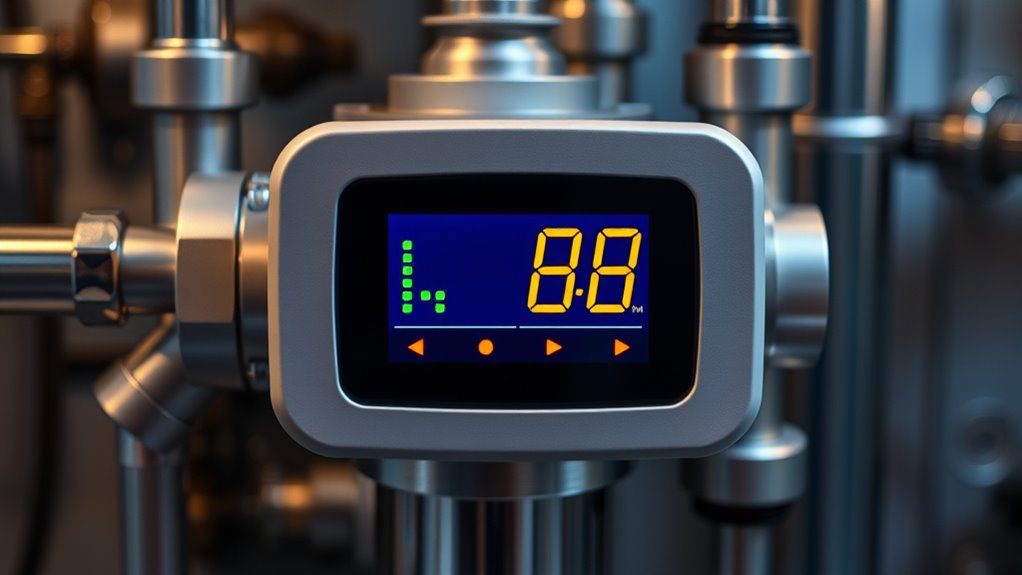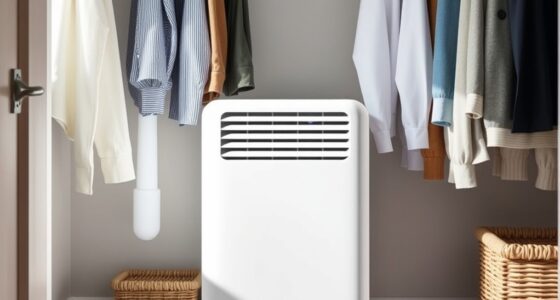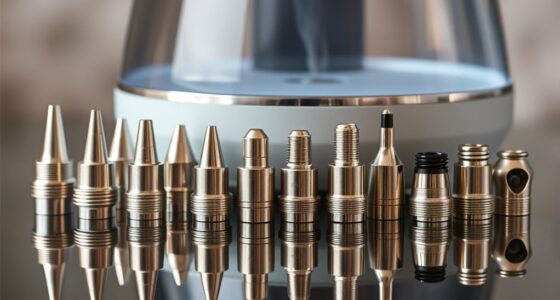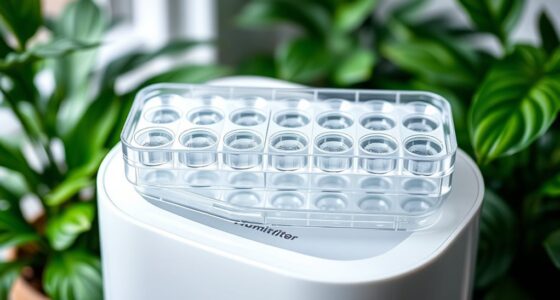I recommend choosing a filter change indicator that’s compatible with your specific filter type and size, easy to install without special tools, and made from durable materials like high-quality plastics or metals. Electronic indicators provide clear digital alerts, while mechanical ones rely on visual cues, so pick what suits your needs best. Considering cost and maintenance is also key to long-term reliability. Keep exploring to find out which device best balances all these factors for your system.
Key Takeaways
- Choose an electronic indicator for real-time digital alerts and easy monitoring.
- Ensure compatibility with your filter media, size, and connection method for seamless integration.
- Opt for durable materials like corrosion-resistant plastics and impact-resistant components for longevity.
- Select a device with straightforward installation features, including quick mounting and simple wiring.
- Consider maintenance needs, favoring models with reusable parts and clear calibration instructions for cost efficiency.
UView Automotive Combustion Leak Test Kit
https://m.media-amazon.com/images/I/61wrY08KjxL._SX522_.jpg
If you’re looking for a reliable way to detect combustion gas leaks in both gasoline and diesel engines, the UView Automotive Combustion Leak Test Kit is an excellent choice. I find its dual-chamber system particularly helpful, as it filters out false readings caused by alkaline particles. The color-changing fluid clearly indicates leaks, shifting from blue to yellow or green, making diagnosis straightforward. Its durable, portable case and quality construction guarantee it lasts through many tests. Whether you’re a DIY enthusiast or a professional mechanic, this kit offers accurate, easy-to-understand results that help identify head gasket failures, cracked engines, or water pump issues efficiently.
Best For: DIY enthusiasts and professional mechanics seeking an accurate, reliable tool for detecting combustion gas leaks in both gasoline and diesel engines.
Pros:
- Dual-chamber system effectively filters alkaline particles, reducing false positives.
- Color-changing fluid provides clear, visual leak indication from blue to yellow or green.
- Durable, portable case and quality construction ensure longevity and ease of use.
Cons:
- Rubber components may dry out or crack over time with extensive use.
- Proper handling and preparation are essential to avoid false results.
- Increased fluid consumption due to the dual-chamber design may slightly raise ongoing costs.
Factors to Consider When Choosing a Filter Change Indicator Device
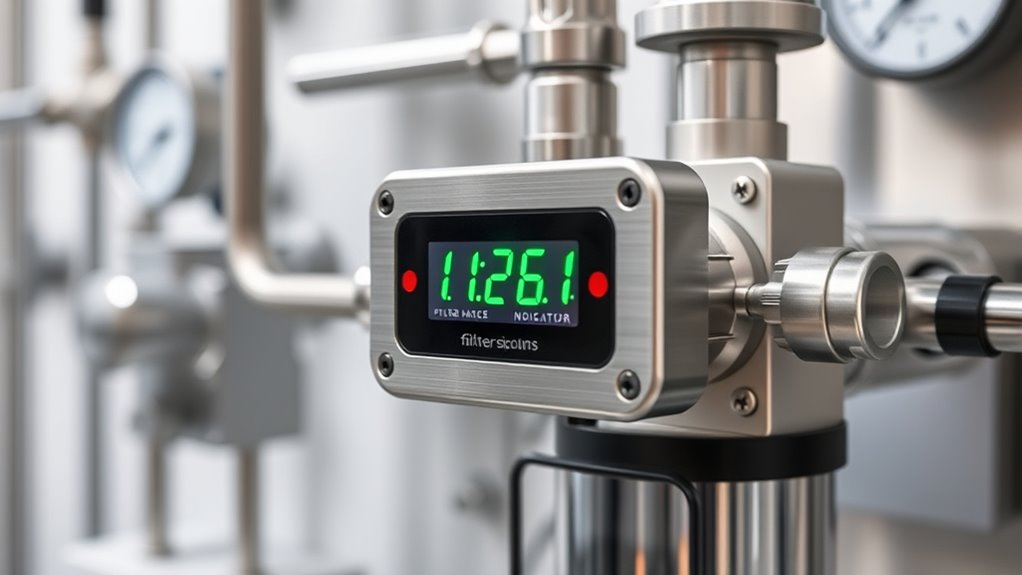
When selecting a filter change indicator device, I look at how well it works with my filters and the types of indicators available. Ease of installation and durability are also key, so I don’t spend too much time maintaining it. Finally, I consider the cost to guarantee I get a reliable device without overspending.
Compatibility With Filters
Choosing a filter change indicator device begins with making sure it’s compatible with your specific filter type and size. You need to check that the device supports your filter’s connection method, whether it’s threaded, clip-on, or snap-in. It’s also important to verify that the indicator can handle your system’s flow rate and pressure requirements to avoid inaccurate readings or damage. Additionally, confirm that the device is suitable for your filter media, whether paper, foam, or synthetic. Reviewing the manufacturer’s guidelines helps ensure the indicator is designed for your filter’s operational environment and chemical exposure, preventing compatibility issues. Taking these steps guarantees that the device will work reliably, keeping your system running smoothly without unnecessary interruptions.
Indicator Type Options
Selecting the right filter change indicator involves understanding the different types available, each offering unique detection methods. Electronic indicators use sensors to monitor filter conditions and often provide digital alerts or signals, making them highly precise and easy to read. Mechanical indicators rely on physical changes, like color shifts or mechanical movement, to signal when a filter needs changing, which can be simple and reliable. Chemical-based systems involve reactive substances that change color at specific contamination levels, offering a visual cue without electronics. When choosing an indicator type, consider compatibility with your system, how easy it is to interpret the signals, and the maintenance involved. Each type has its advantages, so understanding these differences helps ensure you select the best fit for your needs.
Ease of Installation
Ease of installation plays a crucial role in guaranteeing you can set up your filter change indicator quickly and correctly, even without technical expertise. Look for devices with clear, straightforward mounting options that don’t require specialized tools, making setup hassle-free. Models with intuitive connection points that match existing filter setups help minimize installation time. Devices featuring plug-and-play wiring or simple clip mechanisms further streamline the process, accommodating users of all skill levels. It’s also helpful if installation instructions are concise and come with visual aids or diagrams to eliminate guesswork. A user-friendly design often includes adjustable components or modular parts, allowing for quick attachment and removal. Overall, choosing a device with easy installation features saves you time and ensures your system stays protected without frustration.
Durability and Material
Durability and materials are vital factors when selecting a filter change indicator device, as they determine how well the unit withstands harsh engine conditions. High-quality plastics or metals are ideal because they resist corrosion, heat, and chemical exposure common in automotive environments. The rubber gaskets and seals should be made from flexible, long-lasting materials like silicone or EPDM to ensure a tight seal over time. Impact-resistant components are essential to prevent damage from vibrations or accidental knocks. The overall longevity of the device depends heavily on the quality of its materials; premium options typically last longer and are less prone to failure. Choosing a device built with durable, resistant materials means fewer replacements, more reliable performance, and peace of mind during regular maintenance.
Cost and Maintenance
When choosing a filter change indicator device, cost and maintenance are essential factors that can impact your long-term investment. Upfront costs vary widely, with more advanced models costing more initially. It’s also important to contemplate ongoing expenses, such as replacing sensors or electronic parts, which can add up over time. Devices with reusable components or simple-to-replace parts tend to be more cost-effective in the long run. Regular maintenance, like calibration or sensor replacement, ensures accurate readings and reliable performance. Additionally, thinking about how often you’ll use the device and its durability can help you choose a model that offers the best value. Balancing initial price with maintenance needs ensures you get a device that’s both effective and economical over time.
Frequently Asked Questions
How Long Does a Typical Filter Change Indicator Device Last?
You’re probably wondering how long a filter change indicator device lasts. Typically, these devices are designed to last around 1 to 3 years, depending on the model and usage. I recommend checking the manufacturer’s guidelines for your specific device. Regular maintenance and monitoring help guarantee it functions properly, alerting you when it’s time to replace your filters. This way, your system keeps running smoothly without unexpected breakdowns.
Are Filter Change Indicators Compatible With All Filter Types?
When it comes to filter change indicators, compatibility is key. I find that many devices are designed for specific filter types, so they may not work with all filters. It’s essential to check the product specifications before purchasing. I always verify the indicator matches my filter type to avoid mismatches. Compatibility matters because it guarantees accurate alerts, protects my system, and keeps everything running smoothly without unnecessary replacements or repairs.
Can Filter Indicators Be Reset After a Filter Change?
Yes, filter indicators can be reset after a filter change. I usually follow the manufacturer’s instructions, which often involve pressing and holding a button or turning a dial to reset the device. It’s a quick process that helps guarantee your system accurately tracks when the next filter change is due. Always double-check your specific model’s guide, but resetting is generally straightforward and essential for maintaining peak performance.
Do Electronic Filter Indicators Require Regular Maintenance?
Thinking of electronic filter indicators like the heartbeat of your system, they do need some TLC. I’ve found that regular maintenance, like cleaning sensors and checking batteries, keeps them accurate and reliable. If you neglect them, they might give false readings or stop working altogether. So, just like you’d service your car, give your electronic indicator occasional attention to make sure it helps your system run smoothly.
What Is the Cost Difference Between Manual and Automatic Indicators?
You’re wondering about the cost difference between manual and automatic filter indicators. I’ve found that manual indicators are usually more budget-friendly upfront, often costing around $10 to $30. Automatic indicators tend to be pricier, ranging from $50 to $150 or more, but they offer the convenience of real-time alerts without manual checks. Ultimately, I think it’s worth investing in automatic ones for peace of mind and convenience.
Conclusion
Think of a filter change indicator device as the heartbeat monitor for your system. It keeps you in tune with your vehicle’s needs, preventing surprises and costly repairs. By choosing the right one, you’re fundamentally giving your system a trusted co-pilot, guiding you smoothly through every mile. Don’t wait for a warning sign—stay proactive, keep your system healthy, and enjoy the ride with confidence. Your vehicle’s well-being is worth it!
